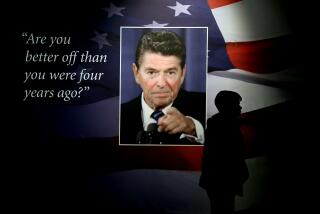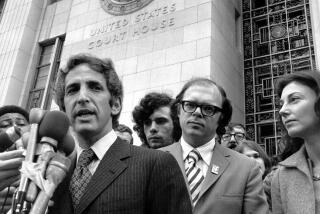John Dean takes a fresh look at Watergate in ‘Nixon Defense’
- Share via
“My voice on the Nixon tapes is really very clear and very good,” says John Dean, adjusting the microphone recording him on a summer day in Westwood. Aug. 9 marks the 40th anniversary of President Richard M. Nixon’s resignation from office, and Dean is publishing a new book, “The Nixon Defense: What He Knew and When He Knew It,” a day-by-day chronicle of the Watergate scandal.
Although Watergate has been explored in books and film, some of the story has not yet been told, Dean says.
“I knew enough to know that we didn’t have a very full picture,” he explains. “I intentionally don’t flag new material in the book, but almost every page there’s something I didn’t know.”
Going back to the original tape recordings, “The Nixon Defense” (Viking: 784 pp., $35) starts with Nixon’s first conversation about the Watergate break-in in June 1972 and ends in July 1973, when his secret taping system was dismantled.
The book is an exhaustive return to the scene of the crime — crimes that would send Dean, former Atty. Gen. John Mitchell, Nixon aide John Erlichman and White House Chief of Staff H.R. “Bob” Haldeman to prison. They, and Nixon, were trying to keep the unraveling story of Watergate — the break-in of Democratic National Committee headquarters by five operatives being paid by G. Gordon Liddy and E. Howard Hunt — from reaching the White House.
History has shown that was impossible. Nixon was forced to resign over the cover-up.
“His weird conception of a cover-up stunned me,” Dean says. The book shows that Nixon believed that the efforts to prevent tracing the break-in back to the White House didn’t constitute a cover-up because they were arranging for someone to take the fall. Dean explains Nixon’s logic: “As long as these guys who were arrested at the DNC and Hunt and Liddy get it, well, it’s not a cover-up.”
Now 75, Dean barely resembles the man who, in June 1973, testified before the Senate committee investigating Watergate and national television cameras. He’s genial, relaxed; these days, you might even catch him circulating cat pictures on Twitter.
Dean famously said there had been a cover-up, but it was initially his word against Nixon’s and that of the rest of the White House. “When I broke rank, I was naive enough to believe that by starting the process, I thought the others would follow me,” he says now. They did not.
It was only after the revelation that Nixon had recorded all his conversations — startling to all but handful of the president’s staff — that Dean was proved to have told the truth.
“Clearly this has been an abiding concern of his ever since he left the administration — and understandably so,” says historian David Greenberg, author of “Nixon’s Shadow: The History of an Image.” “I can understand the desire to say, ‘OK, don’t take my word for it. Let’s look at all the tapes.’”
Dean and his research assistants spent four years listening to those tapes, going over and updating existing transcripts and combing through previously unreleased materials to construct a narrative of the 1,000 or so Watergate-related conversations Nixon had.
At times, the intense focus on Watergate makes for an uneven account — Nixon’s involvement in the discussions about the Vietnam War get passing mention, included only because it accounts for the president not mentioning Watergate for a few days. Meanwhile, streamlining Nixon’s eventual obsession with Watergate into a digestible narrative wasn’t easy.
“Nothing was more challenging,” Dean says. “He knows he’s in deep trouble, and it manifests itself in these endless rehashing, reshaping, twisting, turning conversations. ... It would kill a reader to have to read all that.”
Dean shapes those conversations into a readable, dense narrative. (Many of the transcripts themselves can be found in “The Nixon Tapes,” edited by Douglas Brinkley and Luke A. Nichter, also published this month.) These are unique historic records, Dean points out. “We’ll never have another record like this of a presidency,” he says. “It’s just such a rich history.”
While subsequent presidents tape official conversations, none has set up a system like Nixon’s; because it was voice-activated, it captured everything that was said in his offices.
“I think the reason that Haldeman and [Alexander] Butterfield put [the recording] system in that way [voice-activated] is because they figured Nixon was so awkward he would never turn the switch on when he should and turn it off when he should,” Dean says. “This was a guy who could not figure out how to open a medicine bottle, where you have to press down on the top and turn it? I’d see him with those bottles in his mouth. Literally sometimes [he’d] fumble getting his desk drawer open. Haldeman and Butterfield were well aware of that. I think that’s part of the reason they put this voice-activated system in. Either that or [Nixon] might fly across the room and hit the switch and make it very obvious what he was doing.”
Although Dean and Nixon were divided by choices and betrayals, they are still inevitably linked.
“Dean’s identity remains, above all, tied to Watergate,” Greenberg says. Some baby boomer liberals, like my parents, consider him a villain. But, Greenberg says, “he remains the guy who blew the whistle on the administration. That’s something that he will always have a certain heroic place in history for having done.”
Follow me on Twitter @paperhaus
More to Read
Sign up for our Book Club newsletter
Get the latest news, events and more from the Los Angeles Times Book Club, and help us get L.A. reading and talking.
You may occasionally receive promotional content from the Los Angeles Times.










